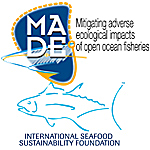The deployment of thousands of drifting man made fish aggregating devices (FADs) by fishers over recent decades has modified the pelagic habitat where only natural floating objects (logs) could be encountered before. Previous studies highlighted that tunas associated with floating objects were in lower conditions than tunas in free-swimming schools (FSCs), concluding that FADs could act as ecological traps. However, the interpretations of these results require a reference point, i.e. the condition of tunas before the use of FADs. Considering that the associative behaviour of tunas with logs evolved to provide some advantages, it is generally assumed that before the fishery, tunas associated with logs would have been in a similar or superior condition to tunas in FSCs. In the Mozambique Channel, an area known to be naturally enriched with logs, with few FADs, we tested the hypothesis that the condition of skipjack tuna (Katsuwonus pelamis) associated with logs was similar or superior to those of tuna in FSCs. Our results reject this hypothesis. Morphometric and bioenergetic indices revealed poorer body condition for tuna associated with logs. These results preclude scientists from interpreting differences in fish health caught around floating objects and in FSCs as an unequivocal demonstration that FADs act as ecological traps. Biochemical and morphometric indices suggested that females could be more affected by the association with logs than males, a new hypothesis that deserves further investigation. Our study also provides new insights in our understanding of the evolutionary origins of this associative behaviour.
- Presentation

 PDF version
PDF version
